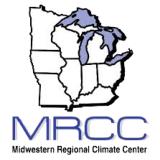Drought Is Likely to Persist Across the Midwest with an El Niño Winter Ahead
Key Points
- According to the U.S. Drought Monitor, 43% of the Midwest region is in drought, with the most intense conditions of Extreme Drought (D3) in Iowa and portions of Missouri. Drought conditions intensified this fall across portions of the lower Midwest, particularly in Kentucky, southern Illinois, and Indiana.
- Water is limited across the Midwest region. Streamflow and soil moisture are below normal in many areas, municipal water supply is being affected, and surface ponds for livestock are dry across Kentucky, Iowa, and Missouri. Wildfire was a significant issue in Kentucky in November due to the dry conditions.
- Mississippi River water levels remain below normal for this time of year as conditions have been dry, and dredging continues to maintain the 9-foot navigation channel on the Mississippi from St. Louis southward. Water levels on the Mississippi River are expected to continue to trend lower throughout much of December, and the potential for an “ice bite” or the rapid formation of ice on the Upper Mississippi River is a concern for Lower Mississippi navigation this winter.
- Strong El Niño conditions have developed in the Pacific Ocean and are expected to continue. While each El Niño event is different, El Niño winters (Dec-Jan-Feb) tend to be warmer and drier across the Midwest.
- As a result, NOAA’s seasonal drought outlook expects drought to persist across the region this winter. With dry soils and limited water across the region already an issue, the persistence of drought could leave many areas across the Midwest in a vulnerable position leading into the spring and the 2024 growing season.
The U.S. Drought Monitor depicts the location and intensity of drought across the country. The map uses 5 classifications: Abnormally Dry (D0), showing areas that may be going into or are coming out of drought, and four levels of drought (D1–D4).
The U.S. Drought Monitor is a joint effort of the National Oceanic and Atmospheric Administration, U.S. Department of Agriculture, and National Drought Mitigation Center.
U.S. Drought Monitor Categories
Abnormally Dry (D0)
Abnormally Dry (D0) indicates a region that is going into or coming out of drought. View typical impacts by state.
Moderate Drought (D1)
Moderate Drought (D1) is the first of four drought categories (D1–D4), according to the U.S. Drought Monitor. View typical impacts by state.
Severe Drought (D2)
Severe Drought (D2) is the second of four drought categories (D1–D4), according to the U.S. Drought Monitor. View typical impacts by state.
Extreme Drought (D3)
Extreme Drought (D3) is the third of four drought categories (D1–D4), according to the U.S. Drought Monitor. View typical impacts by state.
Exceptional Drought (D4)
Exceptional Drought (D4) is the most intense drought category, according to the U.S. Drought Monitor. View typical impacts by state.
The U.S. Drought Monitor depicts the location and intensity of drought across the country. The map uses 5 classifications: Abnormally Dry (D0), showing areas that may be going into or are coming out of drought, and four levels of drought (D1–D4).
The U.S. Drought Monitor is a joint effort of the National Oceanic and Atmospheric Administration, U.S. Department of Agriculture, and National Drought Mitigation Center.
This map is released every Thursday morning, with data valid through Tuesday at 7 a.m. ET.
Current Conditions for the Midwest
- According to the U.S. Drought Monitor, 43% of the Midwest region is in drought. The most intense conditions are in eastern Iowa, where a large swath of Extreme Drought (D3) has persisted since late August. Despite some improvement in November, Extreme Drought also persists in a few areas in Missouri.
- Drought conditions have intensified this fall across portions of the lower Midwest—particularly in Kentucky, southern Illinois, and Indiana, with Severe Drought (D2) affecting southeast Kentucky and south-central Illinois (Figure 1).
- Below-normal fall precipitation has driven the persistence of drought in the region, and expansion of drought in portions of the southern Midwest (Figure 2).
Figure 1: 8-Week U.S. Drought Monitor Change Map (Since October 10, 2023)
The Midwest has seen a mix of improvement and degradation over the last 8 weeks according to the U.S. Drought Monitor. Drought has worsened across southeastern Kentucky and in portions of southern Illinois and southern Missouri by one to three categories in this time frame.
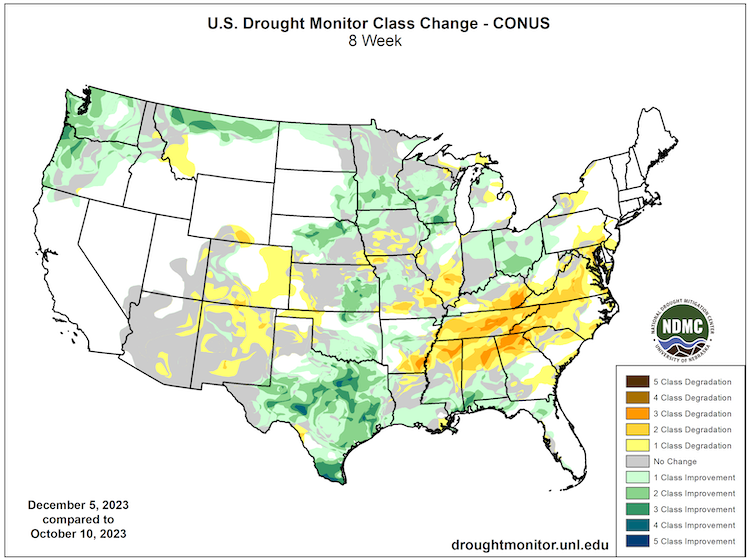
Figure 2: 60-Day Percent of Normal Precipitation (Since October 8, 2023)
Much of the Midwest has had widespread below-normal precipitation this fall, with some areas having only 25%–50% of normal. Areas in the Upper Midwest have had above-normal precipitation, including Wisconsin and portions of Minnesota, Iowa, Illinois, and Michigan.
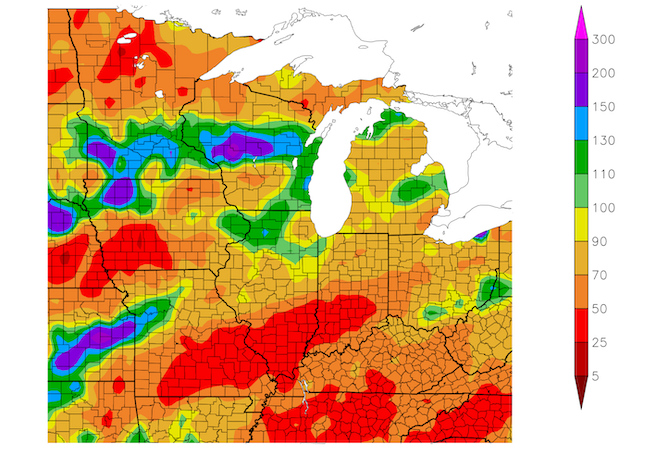
Midwest Drought Impacts
- The main drought impact currently is limited water across the Midwest region. Streamflows are below normal (Figure 3); municipal water supply is being affected; surface ponds for livestock are dry across Kentucky, Iowa, and Missouri (Figure 4); and soil moisture is below normal across Iowa, Illinois, Missouri, Minnesota, Kentucky, and Indiana (Figure 5).
- Municipal water supply has been negatively affected by drought in Iowa, Missouri, and Ohio. In late October, Osceola, Iowa said they have only about 200 days’ worth of water left after enduring three years of drought. After reconfiguring a water intake, the city now has about 330 days' worth of water. Other cities in Iowa have had to explore alternative water sources or enforce water conservation measures.
- Mississippi River water levels remain below normal for this time of year, but levels are not as low as they were in October. The Upper Mississippi River remains dry, and therefore not much water is available to run down the system. Dredging continues to maintain the 9-foot navigation channel on the Mississippi from St. Louis southward due to the low conditions.
- Wildfire has been a significant issue across Kentucky this fall due to the dry conditions. The Governor of Kentucky declared a state of emergency on November 3 to increase the state’s firefighting capacity. Since then, 266 wildfires have burned nearly 34,000 acres in the state. As of November 20, there were no active wildfires in Kentucky.
- Pasture conditions are very poor across Kentucky and Missouri, and supplemental feed and water are required to maintain livestock conditions. Some producers have sold or are considering selling livestock as well.
Figure 3: Current Streamflow Conditions (Valid December 6, 2023)
Persistent drought conditions this fall have resulted in below-normal streamflow across many areas in the Midwest, including Iowa, Indiana, Illinois, Kentucky, Missouri, and Ohio.
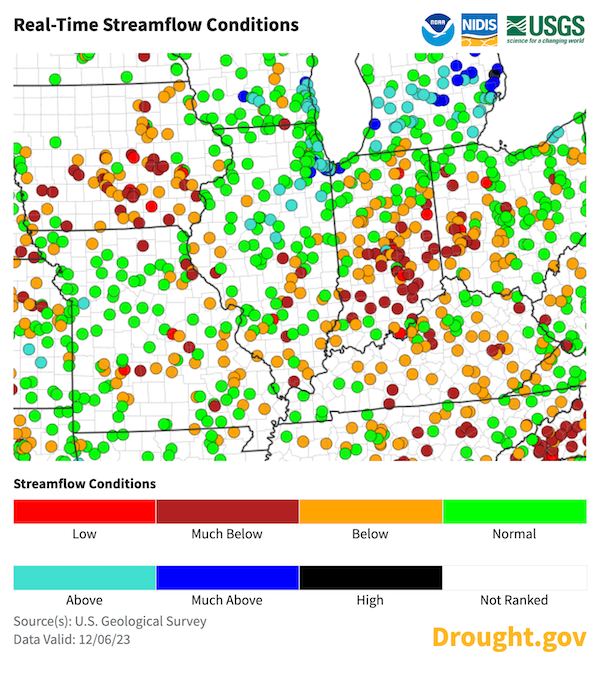
Figure 4: Pond Conditions in Montgomery County, Kentucky on November 15, 2023
Many surface ponds are low across the Midwest. This photo shows one example from Montgomery County in Kentucky in mid-November.
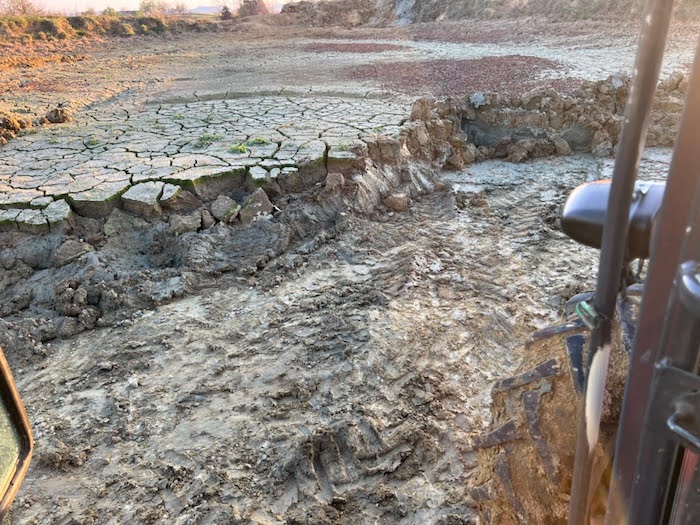
Figure 5: Soil Moisture Percentiles from the CPC Leaky Bucket Model (Valid December 6, 2023)
Soil moisture remains limited in many areas of the region, including Iowa, Minnesota, Missouri, Illinois, Indiana, Kentucky, and Ohio, where soil moisture percentiles are below normal for this time of year.
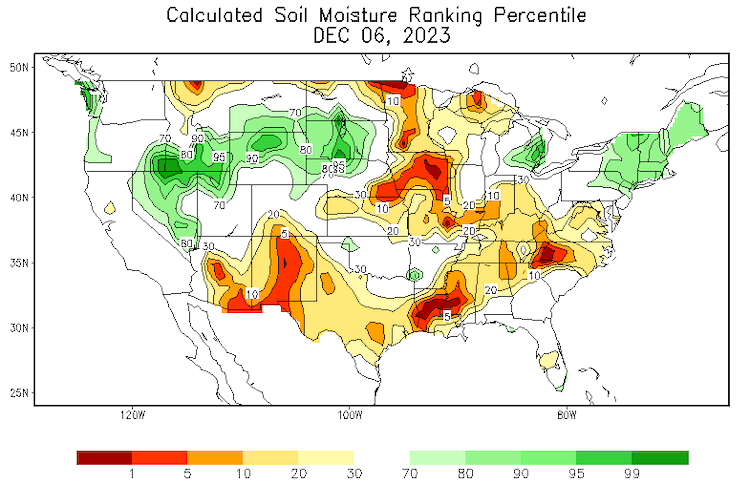
Report your local drought impacts through a Condition Monitoring Observer Report:
Outlooks and Potential Impacts
- December temperatures are likely to be above normal across the region (Figure 6), with slightly higher chances of below-normal precipitation in the Upper Midwest (Figure 7).
- With limited precipitation in the forecast, water levels on the Mississippi River are expected to continue to trend lower throughout much of December. Wintertime increases the concern for “ice bite,” which is when a significant cold air outbreak leads to rapid ice formation on the Mississippi River. An “ice bite” locks water into place on the river and prevents downstream movement, which could cause significant issues south of St. Louis in the Lower Mississippi where navigation operations continue throughout the winter.
- El Niño conditions have developed in the Pacific Ocean and are expected to continue. While each El Niño event is different, El Niño winters (Dec-Jan-Feb) tend to be warmer and drier across the Midwest.
- NOAA’s winter outlook for December through February shows an increased chance of above-normal temperatures and a slightly increased chance of below-normal precipitation across the Great Lakes and eastern Midwest, with equal chances of above-, below-, and near-normal precipitation elsewhere. As a result of this winter outlook, drought is expected to persist across the region with the exception of southern Missouri, where improvement is expected (Figure 8).
- With dry soils and limited water across the region already an issue, below-normal precipitation this winter could exacerbate issues. This could leave many areas across the Midwest in a vulnerable position leading into the spring and the 2024 growing season.
Figure 6: December Temperature Outlook
Widespread above-normal temperatures are expected in December across the Midwest region.
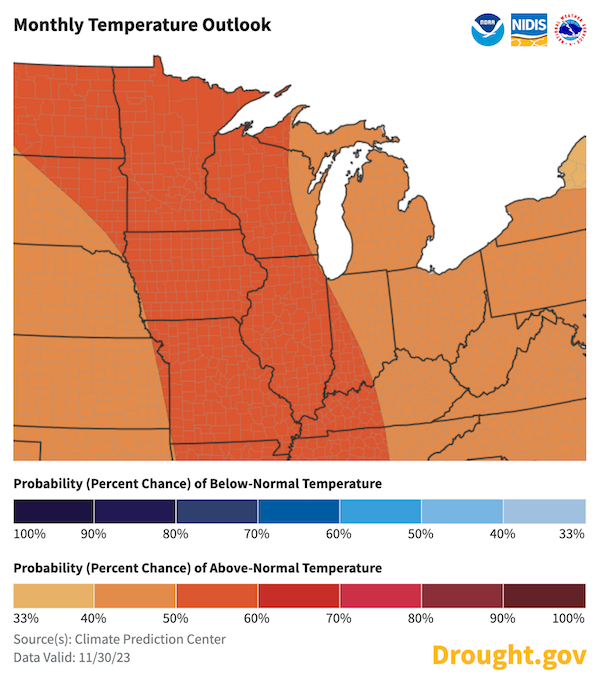
Figure 7: December Precipitation Outlook
Precipitation has a greater chance to be below normal in December across portions of the Upper Midwest, with increased chances for above-normal precipitation in portions of Missouri. The rest of the region has equal chances for either above-, below-, or near-normal December precipitation.

Figure 8: Seasonal Drought Outlook (Valid December 1, 2023–February 29, 2024)
Drought is expected to persist throughout the winter across areas already in drought (Iowa, Illinois, Indiana, Kentucky Minnesota, Missouri, and Wisconsin), with the exception of southern Missouri, where improvement and even removal of drought is predicted. There often isn’t much change in drought over the winter as soils are often frozen and this limits the ability to replenish soil moisture.
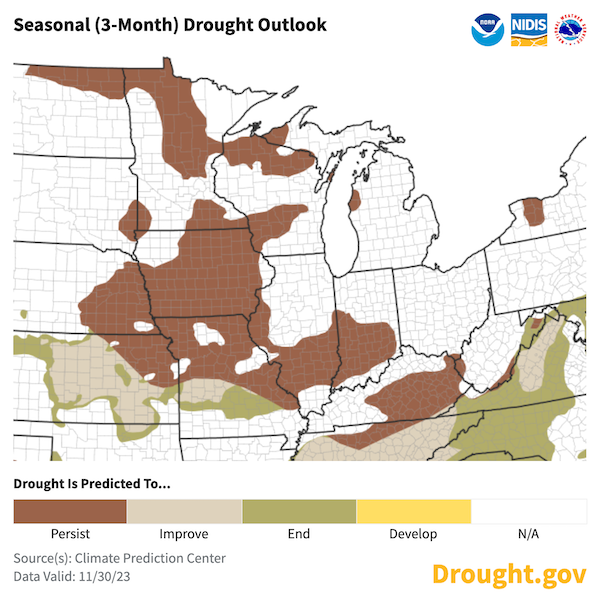
Resources
For More Information
- Read more information about the potential impacts of El Niño in the Midwest this winter in the November 2023 El Niño Impacts and Outlook report from NOAA and partners.
- More local information is available from the following resources:
- To report or view local drought impact information:
- Register for the December 21 North Central U.S. Climate and Drought Summary & Outlook Webinar, which will provide an overview of climate and drought conditions, impacts, and outlooks.
Prepared By
Molly Woloszyn
NOAA/National Integrated Drought Information System (NIDIS), CIRES/CU Boulder
Doug Kluck
NOAA/National Centers for Environmental Information
Dennis Todey & Laura Nowatske
USDA Midwest Climate Hub
Audra Bruschi
NOAA/National Weather Service Central Region
Jim Noel & Mike Welavert
NOAA/National Weather Service/Ohio and North Central River Forecast Center
Anna Wolverton
U.S. Army Corps of Engineers Mississippi Valley Division/NOAA National Weather Service
Melissa Widhalm
Midwestern Regional Climate Center/Purdue University
Denise Gutzmer
National Drought Mitigation Center
Trent Ford
Illinois State Climate Office, University of Illinois/Prairie Research Institute
This drought status update is issued in partnership between the National Oceanic and Atmospheric Administration (NOAA) and the U.S. Department of Agriculture (USDA) to communicate a potential area of concern for drought expansion and/or development within the Midwest based on recent conditions and the upcoming forecast. NIDIS and its partners will issue future drought status updates as conditions evolve.








